(This page is about printed dialog in the comics, not emails to the site.
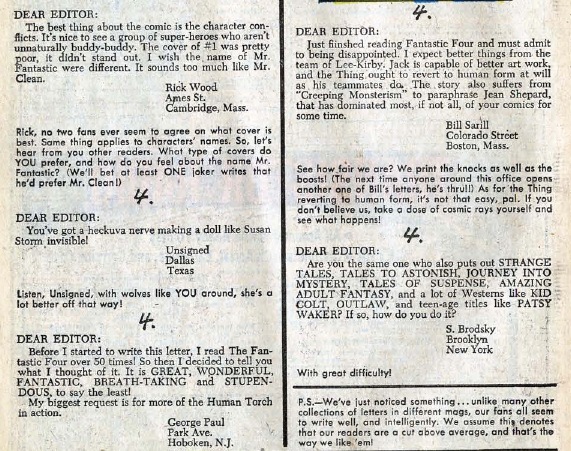
Planning, printing and distributing a comic takes several months, so the letters page always lags behind. At least one of these first letters are obviously fake (S. Brodsky is Sol Brodsky, worked for Marvel and even appeared as the Human Torch in Kirby's "What If" issue where the bullpen becomes the Fantastic Four. ) Inker Dick Ayers later confirmed that some of the early letters were written by Stan. The absence of many fan letters means that fan respnse is not the reason for the team getting uniforms in issue three as sometimes stated..
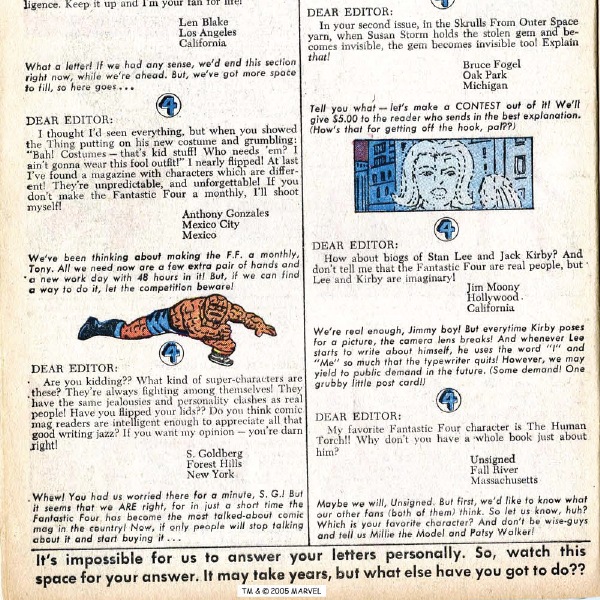
Here we see fans contributing to the story. They asked for it the book (then bi-monthly) to be monthly, and it happened. They asked for a book featuring just the Human Torch, and it happened. They had high expectations of realism, and Stan listened: the five dollar prize for solving a continuity error is the forerunner of the "no prize" - the system whereby every fan considers it his noble duty to fix continuity blunders.
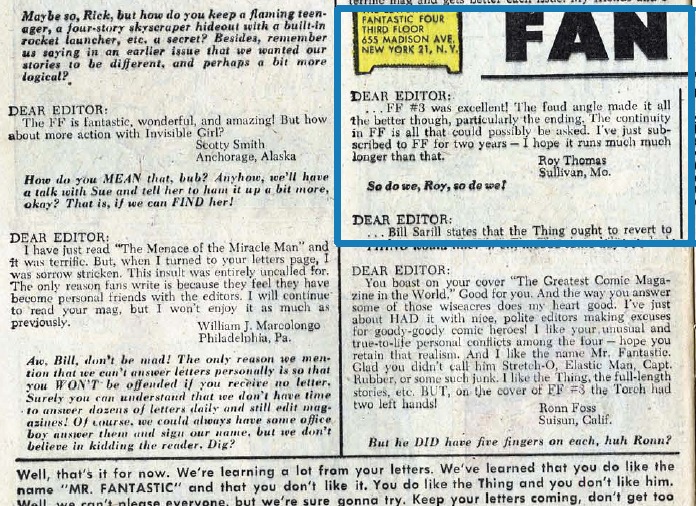
Roy Thomas, here with his first printed fan letter, later became
Stan's assistant and a major figure in comics history. Other
famous letter writers (thanks
to Bully for spotting most of these) include:
Paul Gambaccinni (famous British DJ, FF9)
George R. Martin (of Game of Thrones fame, FF20)
Dave Cockrum (FF36)
Gerry Conway (FF50)
Denny O'Neil (FF53)
Tony Isabella (FF74)
Don McGregor (FF80)
Alan Kupperberg (FF101)
J. M. DeMatteis (FF101)
Note the letter below Roy's: the Torch had two left hands on the
cover.
Wrong hands are a running joke in the comic. Most famously, Reed
has two left hands in the splash page to issue 88. He has a right
hand on his left arm on the cover of FF117. Then he has a hand at
the end of his leg in issue 152. It symbolizes how Reed makes
mistakes, and sometimes his actions seem "sinister" (literally
left handed).
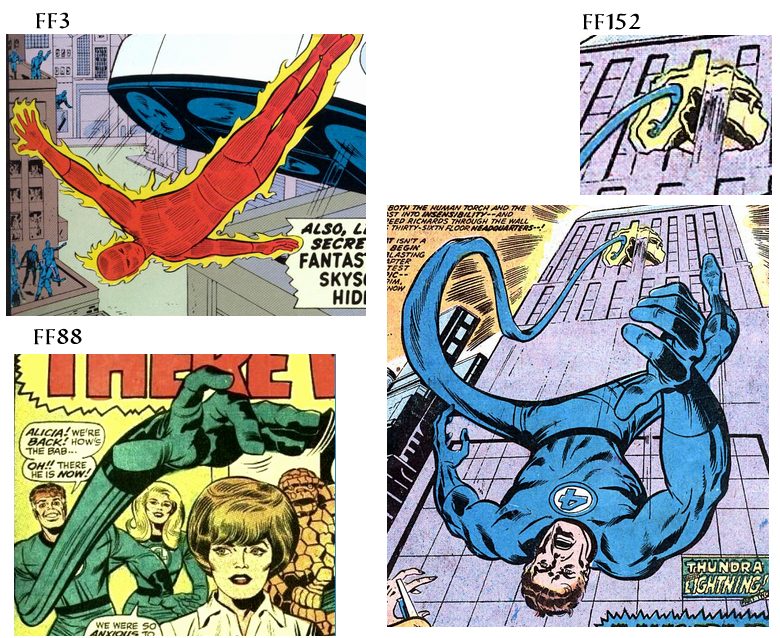
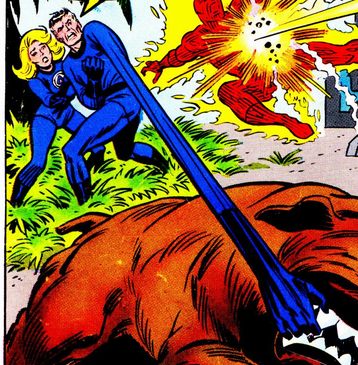
This also illustrates how continuity can fix itself. The artist is more likely to make mistakes when drawing someone who changes form, but if they change form then who is to say the mistake is really a mistake? Reed's body changes shape, and early issues showed him forming extreme shapes, including a wheel with spokes. In issue 88 he needed a thumb at the other side of his hand to support his baby's head (and a hand with two thumbs may have scared the child). In issue 152 he needed a hand at the end of his leg to grab his enemy. As for the Torch in issue 3, covers are often symbolic (e.g. issue 1 showed events that did not literally happen in the comic). At the end of issue 3 Johnny leaves the team, so perhaps his two left hands show that something sinister is going on. or perhaps they are one of the Miracle Man's illusions. or perhaps he is experimenting with flame copies of himself and has not yet got it right.
P.S.the two handed fun continues in other books: this is from the
1968 "Big Little Book" called "The House of Horrors", illustrated by
Herb Trimpe. note the two right hands.
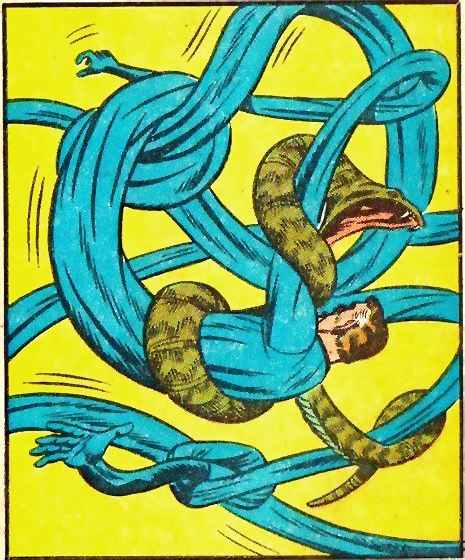
OK, and feet as well: this is from FF 55 (as pointed out in the "Wait What" podcast)
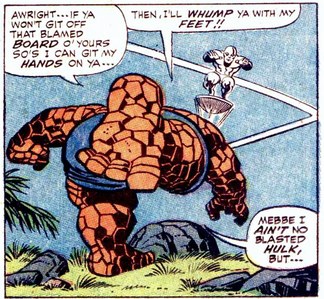
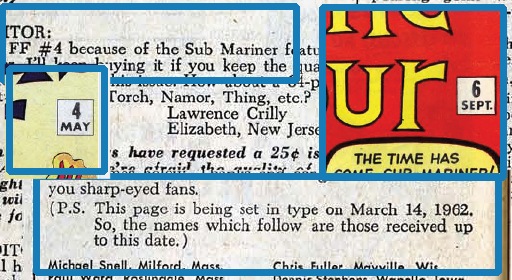
As noted above, the letters page lags behind the printed comic. Note that Stan treats his readers as insiders, even telling us exactly when the reply was typed, so we can better understand the production process.
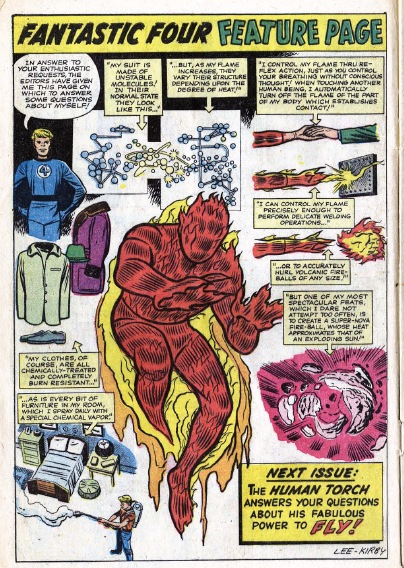
It is a great irony that early comics, while often derided as unrealistic, cared passionately about realism. Reader expected, and received, down to earth explanations. A close analysis reveals that the science of the early heroes was internally consistent.
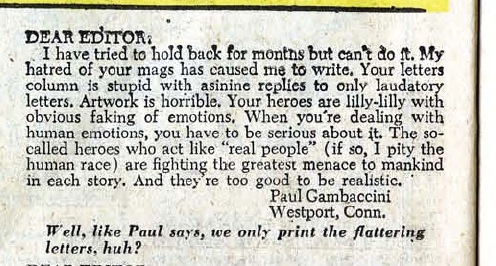
Yes, this is the same Paul Gambaccini who later became a top disk
jockey and media personality. Note that the letters pages
attracted thoughtful comment, and Stan and Jack took them
seriously, even the complaints. Unfortunately this letter is too
vague to be useful, and "only laudatory letters" is not true (see
above)
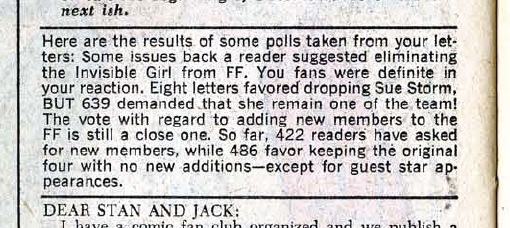
Some readers look back on the early Sue as weak and a burden to the team. Nothing could be further from the truth! Readers at the time saw her value and overwhelmingly supported her.
Reader William Paul writes:
"One request: if anything comes of the fondness which Alicia showed
for the Thing, don't let it dangle on and on like other mags do."
Embarrassing shuffling of feet...
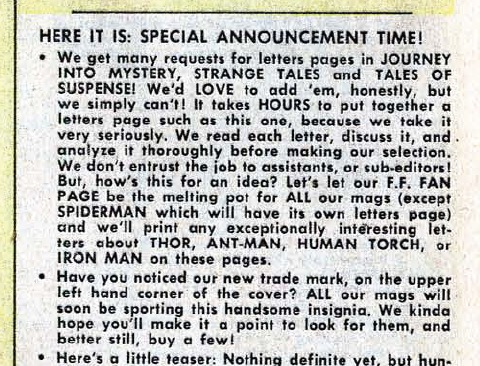
In the early days, letters to all of Marvel's comics were published in the Fantastic Four, the central, flagship book. All other comic books were secondary. Also note that Marvel is now a shared universe, a single entity, with a strong brand. Before the Fantastic Four, Stan's comics had been low quality knock offs of other peoples' ideas, with no connection and no reason to care who published them. The Fantastic Four changed all that, created America's biggest comics juggernaut, made every other comics company copy their approach, and revolutionized the industry.
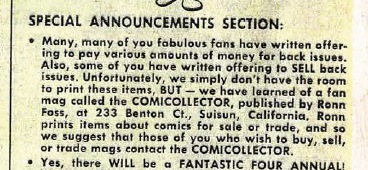
Comics were previously throw-away items. Thanks largely to the Fantastic Four they now have value to collectors. Not just for re-reading, but because new readers want to now how the big story got to where it is today. Note to investors and businessmen: continuity means you can sell the same book again and again to new generations of readers!
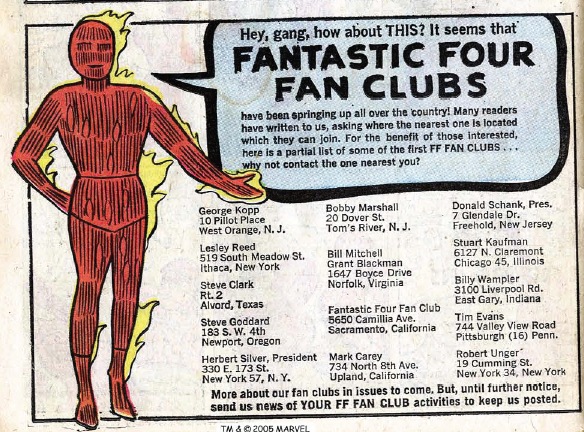
Every month new fan clubs appeared. A few months later there were too many to print. By issue 29 Stan had a list of over least two hundred.
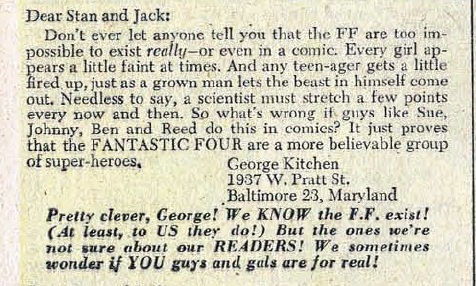
While clearly intended as a joke, this raises an interesting philosophical point: the characters have continuity: what they do affects what happens next. But readers' letters appear in the post almost randomly. as if from nowhere. Which is more real? Which is more like a dream?
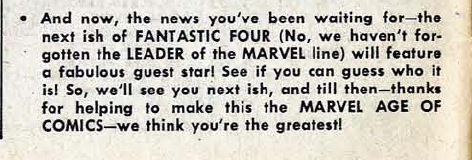
Today the title "world's greatest comics magazine" is strictly a
reflection of past glories. But there was a time when The
Fantastic Four was the undisputed leader of the Marvel line.
Also in FF20: a letter from George R. R. Martin, who would go on
to write "Game of Thrones:"
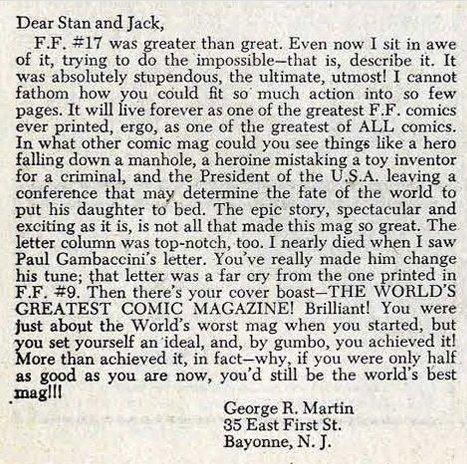
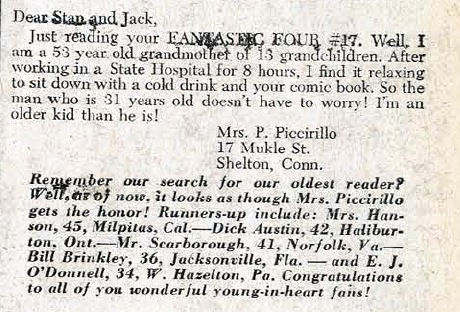
Modern comic writers worry that characters must stay young (hence the sliding time scale and "One More Day" etc.) But there was a time when characters were of all ages (note Reed Richards' white hair) and so were the readers. Publishers may worry where the next generation of readers will come from, but if you appeal to all ages then the kids learn the habit from their parents and grandparents.
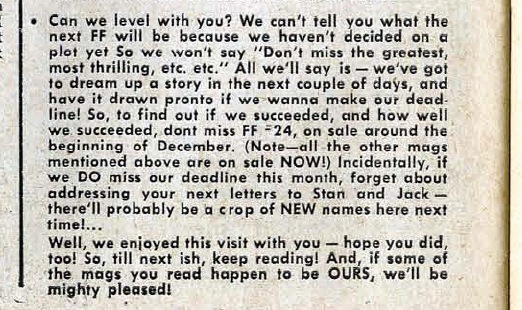
The best comics do focus on planing the future, or being faithful to the past, they are stories that emerge out of the present: writers look at where they are now, and simply ask, "what would happen now? What would be the most incredible thing to happen? Then what would be the most realistic?
This up-to-the-minute approach is reflected in the stories. FF23 was around the time of Kennedy and national optimism (reflected in FF19), and shock following the assassination (reflected in FF21).
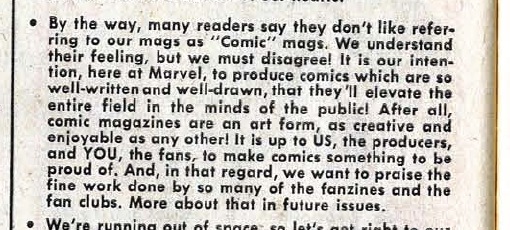
Stan and Jack had the highest aspirations: they wanted to make comics as art, and raise the entire field of comics in the minds of the public. This goal was forgotten in recent years: comics are no longer strict about continuity or realism. But the early Fantastic Four was different. it was a noble and historic achievement.
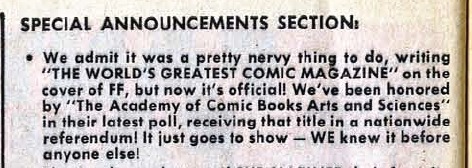
It's official, and they ain't seen nothing yet: this was only issue 25, only half way to the heights reached in Act 3, the unforgettable Galactus saga, This Man This Monster, Doom at his greatest, etc.
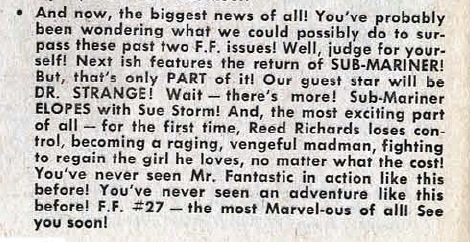
Reed is a deeply layered character. There are passions and frustrations below the surface that rarely surface, but they are there.
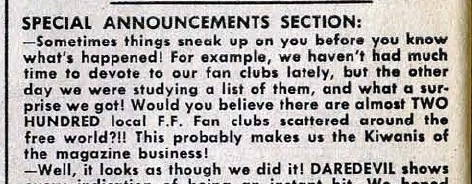
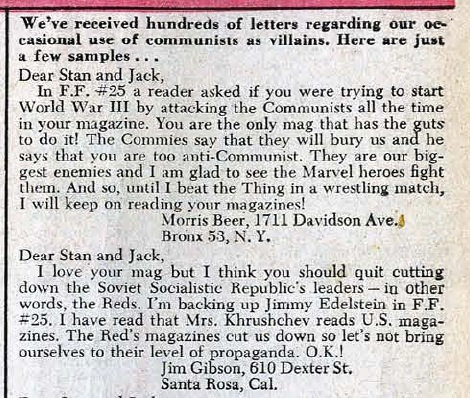
This web site is about the Fantastic Four as the Great American Novel, and identifies political references and character development. Skeptics may ask, "if that is true, why isn't it more clearly stated in the magazine?" Issue 30 gives the answer. There are strong feelings on both sides, so art has to use metaphor and subtlety or half the audience would be offended.
The same problem arises with character development: if you show a character as too unhappy then new readers are scared off. When Sue left Reed, Reed clearly showed his pain. "Comic Creators on the Fantastic Four" mentions how new readers naturally disliked the Fantastic Four in this period. Later writers learned the lesson, and so when Reed had his nervous breakdown at the end of Act 4 he kept smiling: the deep tragedy of those events is only apparent if you look below the surface.
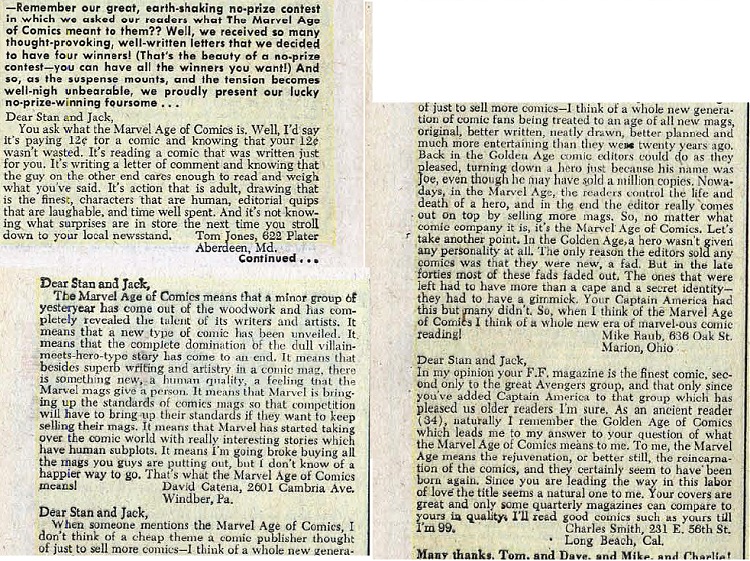
'nuff said.

For more about how Stan and Jack made comics, click here.

All of this in one issue! Contrast this with today's multi part arc, where an adventure will take six issues and have no lasting consequences.

Comic creation was a two way street: for every page that Marvel produced it received several pages of commentary and suggestions.
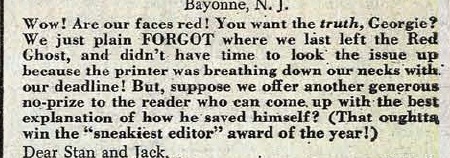
The "no-prize" was a work of genius. Great comics are produced with almost no regard to the past, so continuity errors are inevitable. But the "no-prize" is a way to get the readers to solve the problems, while acknowledging that continuity still matters.

Sue Storm is the heart of the 28 year Fantastic Four story. Note that "most gorgeous gal in comics" probably includes comics by DC and other publishers, and not just superheroes: girls' comics (such as Millie the Model) were still popular.
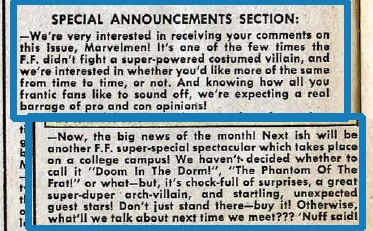
At this stage more college readers are buying the book, so the next story takes place on a college campus. Also, feedback regarding Gideon was clear so he didn't return for many issues (and then he had super powers). As with the early dislike of the Impossible man, this may be because the comics and their readers were still young. Personally I loved the Gideon issue as a refreshing change.
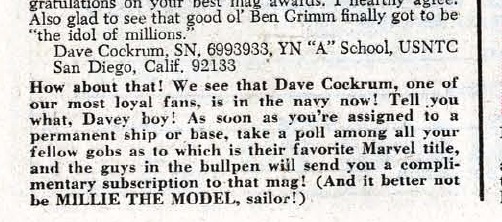
In this period Marvel often sent free subscriptions, especially to the military. And it must have worked: Dave Cockrum went on to become a Marvel artist, co-creating the ground-breaking New X-Men.

Here's a remarkable thing about the incredible power of the early Fantastic Four: Stan Lee would often make wild extravagant claims about his stories being historic, or collectors', or even better than anything that's gone before. And in the period until 1968 most of these claims turned out to be true!

FF44, the first honeymoon issue, the first to reveal the Inhumans, the first Joe Sinnott issue (apart from issue 5) is generally regarded as the start of the greatest comic run ever.
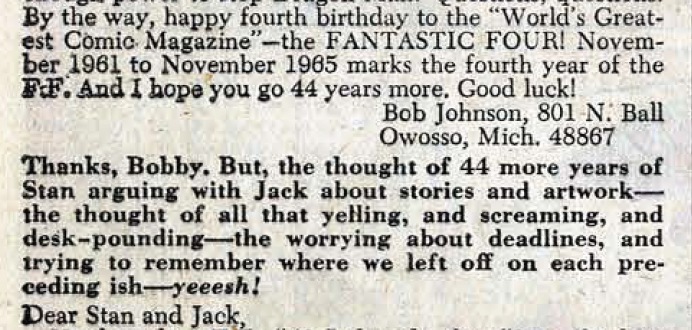
44 years of the FF? It happened. Funnily enough, most of the scans on this web site come from a DVD entitled "44 years of the Fantastic Four."
Note that the greatest comics were made by not planning ahead, but letting realism and amazement go where it will. Stan and Jack did not plan ahead, they just put as much effort as they possibly could into each issue. To plan ahead, as modern writers do, means diluting the stories and replacing realism with artifice.
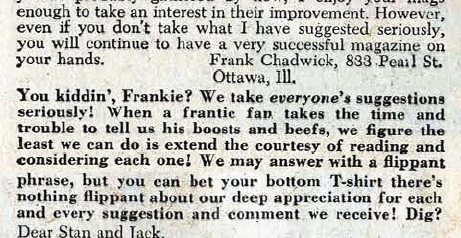
These comics were a collaboration: reader input really mattered.
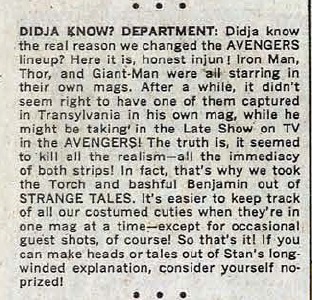
Most people naturally wanted the biggest stars to be in the Avengers, but continuity was king, and it resulted in more interesting stories. This policy is completely abandoned in modern comics, where Spider-Man or Wolverine can appear in literally a dozen different stories per month. Are modern comics more exciting when we toss believability out of the window?
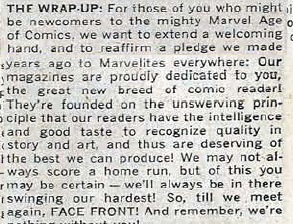
Perhaps Stan was lucky that he didn't have the Internet, but the overwhelming feeling you get from comics creators today, faced with average of fan opinions, is weariness. There are exceptions however - stars like George Perez still make readers feel special. (I must declare a bias here: George Perez is my favorite artist, and his Fantastic Four issues are the greatest ever in my opinion. The greatest tragedy in comics is that he never came back to the FF. But maybe he's waiting for the real FF to return.)
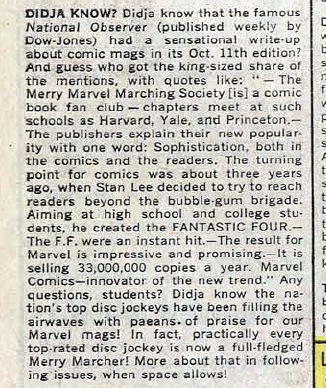
On the subject of college campuses:
"We hear about Stan's emergence as a big draw on the college-lecture circuit, as kids who'd grown up on early Marvel and gone on to post secondary education filled halls to hear him do 20 minutes of patter followed by an endless gulping Q&A. Stan admits he always looked at it as market research; he'd come away from the Q&As with a better understanding of what his audience was responding to. Philosophy majors loved the Silver Surfer, forever wandering the lonely space ways agonizing over man's inhumanity to man. The college gigs were smart branding. Having sold Marvel's comics to children, he then sold them to college kids, then took the idea that college kids were into them and sold it to the world at large as proof that what he did wasn't junk, that comics could punch their weight alongside literature and cinema and modern art and rock and roll. That they might even have something to offer adults. He wasn't the only person who believed this back then (and he may not have believed it at all). But at the time, as spokesman for Marvel and therefore for comics in general, he was basically the only one saying it, with a convivial grin, to Dick Cavett and Rolling Stone and the Washington Post. This is no small legacy." - grantland.com
Regarding the media, issue 49 noted attention from radio
stations. Regarding numbers, the number 33 million looks like a
huge under-estimate: this may be the 1961 figure. By 1966 Marvel was selling 6 million
comics a month, or 72 million per year. Obviously not every comics
was the Fantastic Four, but the FF started the explosion and was
leading the way.
Also in FF50: The increasing interest from other media led to the explosion of merchandising, and the unfortunate discovery that more money can be made (in the short term) by exploiting old stories than by creating new ones. Within two years the priorities would change.
Also in FF50: a letter from Gerry Conway, who went on to write the Fantastic Four:
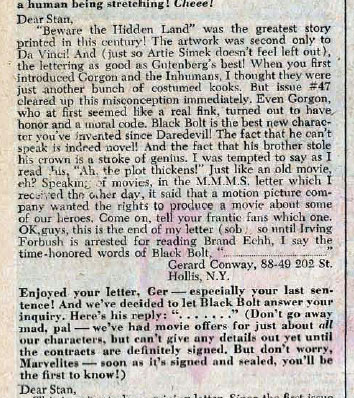
Also in FF50, talking about FF51: there's so much in just one
issue!
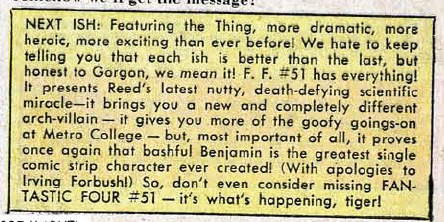
Once again the hyperbole was correct. FF51 is often voted the
greatest comic of all time, with FF50 sometimes coming second.